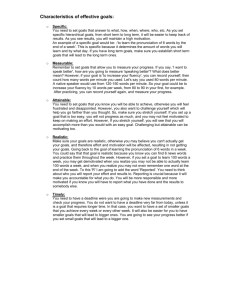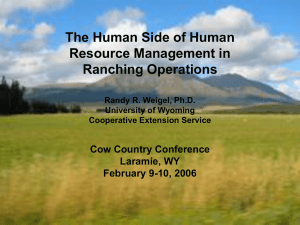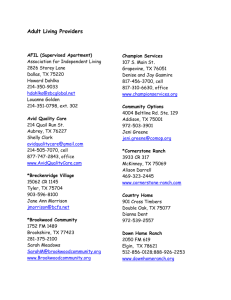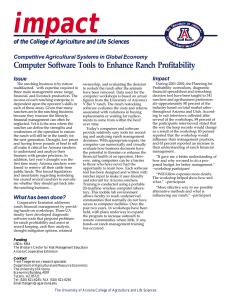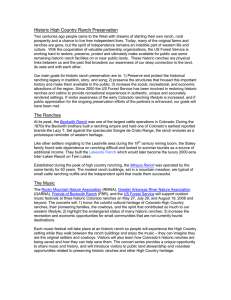Ranch Business Plan Executive Summary Outline
advertisement
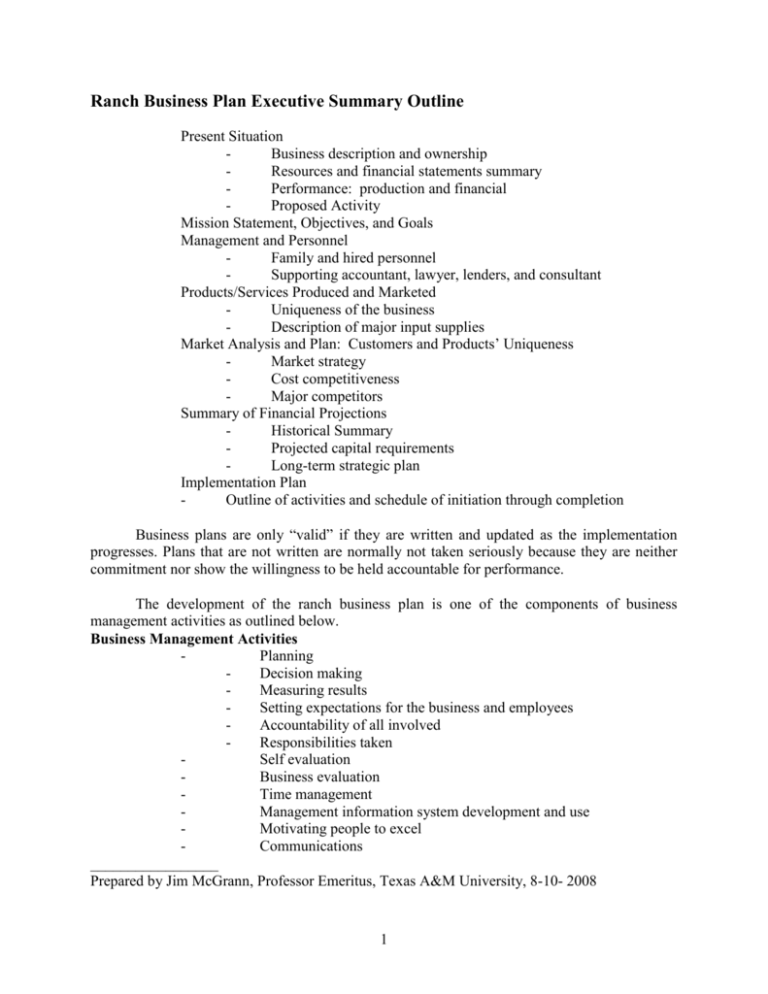
Ranch Business Plan Executive Summary Outline Present Situation Business description and ownership Resources and financial statements summary Performance: production and financial Proposed Activity Mission Statement, Objectives, and Goals Management and Personnel Family and hired personnel Supporting accountant, lawyer, lenders, and consultant Products/Services Produced and Marketed Uniqueness of the business Description of major input supplies Market Analysis and Plan: Customers and Products’ Uniqueness Market strategy Cost competitiveness Major competitors Summary of Financial Projections Historical Summary Projected capital requirements Long-term strategic plan Implementation Plan Outline of activities and schedule of initiation through completion Business plans are only “valid” if they are written and updated as the implementation progresses. Plans that are not written are normally not taken seriously because they are neither commitment nor show the willingness to be held accountable for performance. The development of the ranch business plan is one of the components of business management activities as outlined below. Business Management Activities Planning Decision making Measuring results Setting expectations for the business and employees Accountability of all involved Responsibilities taken Self evaluation Business evaluation Time management Management information system development and use Motivating people to excel Communications _________________ Prepared by Jim McGrann, Professor Emeritus, Texas A&M University, 8-10- 2008 1 Written and timely Commitment Accountability Evaluation Responding to underachievement Business planning is a dynamic activity that defines the direction and expectations that guide participants and their expectations toward the goals of ownership. Ranch Business Plan and Where It Is Used? The business plan development is not a one-time event, but a process that has a number of uses. The plan may address an ongoing business to identify areas for change due to changing goals or missions of the business. It may involve a change in business activity, which requires investment analysis and a projection of its affect on the existing operation. A new ranch business investment or transfer of ownership is most frequently, and rightfully so, a primary motivation to develop a comprehensive business plan. Outlined below are the areas where a business plan is frequently very cost effective. 1. Ongoing business evaluation and projection. Current assessment Projection under current operations Basis for evaluation of current situation 2. Change in the business activity. Investment analysis, or the consideration of the affect on the current operation for the change 3. New ranch business. Investment Operations and management Financing 4. Add outside activities to generate income and investment diversification. 5. Estate planning Objectives and Goals Objectives are general statements describing what the desire is to achieve over time. Goals are specific statements that describe what has to be done to achieve the objectives. Doan’s Agriculture Report describes objectives as having the following characteristics: Directional: Moves you in the general direction of finding ways to complete your mission Reasonable: Intended accomplishments are practical and attainable Inspiring: Outcomes are positive and challenging Visible: Accomplishments are easy to imagine Eventual: Long-term outlook (ten or more years) in fulfilling mission 2 Goals are what are important to achieve success. Doan’s defines the goal attributes as follows: Specific: States only one intention Measurable: An observation can be made to indicate fulfillment Attainable: Is realistic, yet challenging Rewarding: Accomplishment must be valued to maintain persistence Timeliness: Time constraints encourage the development of work strategies Given the fact that ranching is both a way of life as well as an economic endeavor, clearly stating objectives that are consistent and realistic are important in developing useful plans. Defining realistic attainable goals are critical for a business plan to be implemented, as well as the commitment and accountability that are achieved from participants. A frequent objective of ranching is to operate in a way to minimize the necessity to provide non-ranch equity to sustain the business and lifestyle, and to conserve or improve the natural resources. A specific goal could be to increase weaned calf crop five percent while cutting supplemental feed cost 20% in a production cycle. As margins between revenue and cost narrow, the business management objective and associated goals rise to greater importance. Realistically, the quality of lifestyle determines if income shortcomings increase financial risk or owners’ work and stress to keep things together. The vision of the future should not be limited by the past. Rangeland uses are changing. Wildlife management, recreation, resource stewardship, and water quality are all issues that have important economic and resource management roles. When the business plan is being developed for family businesses or for a new ranch investment endeavor, it is highly advisable to develop financial information before writing objectives and specific goals. The entry and exit conditions need to be written. Realistic measures of success reflect the earning capacity of assets invested in ranching and the long-term nature of land appreciation. It also helps planners reflect on the multi-revenue use and lifestyle objectives. Set three or four clearly communicated goals with priorities. Realistic achievable goals motivate execution – getting the job done. More on execution follows. Execution The business plan is only successful if it is executed. This is accomplished by insuring the plan links the strategy to people and results. All the people that will be held accountable for execution need to participate in the planning and goal setting activities. This promotes participant’s “buy in”. Participation should reflect realism in goals and priority selection. Accountability can then be identified with people and specific goals. Execution is promoted by developing and using a measuring system to reward the doers. Leaders in the business must place a premium on getting things done – execution - turns a plan into accomplishments. 3





